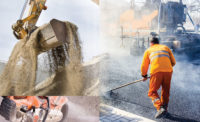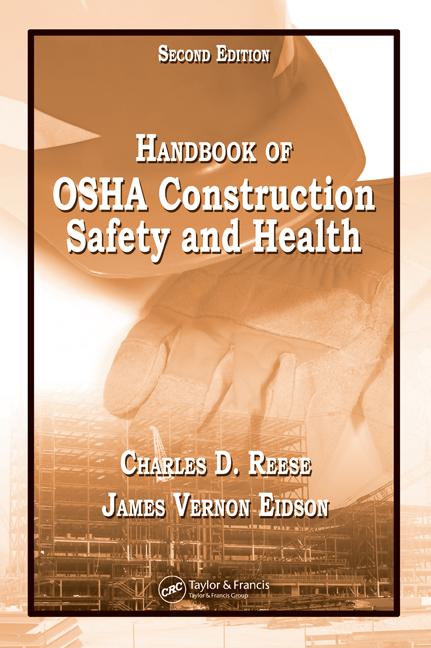Am I covered by the rule?
Approximately 676,000 workplaces will be affected, including sites in construction and general industry and maritime. About 2.3 million workers are exposed to respirable crystalline silica in their workplaces. The majority of these workers, about 2 million, work in construction.
About 295,000 workers are exposed to respirable crystalline silica in more than 75,000 general industry and maritime workplaces. Exposure to respirable crystalline silica can cause silicosis, lung cancer, other respiratory diseases, and kidney disease.
OSHA estimates that more than 100,000 workers in general industry and maritime are exposed to silica levels that exceed the new permissible exposure limit (PEL).
What is the new permissible exposure limit (PEL) for respirable crystalline silica (RCS)?
The PEL limits worker exposures to 50 micrograms of respirable crystalline silica per cubic meter of air (µg/m3), averaged over an eight-hour day. This level is the same for all workplaces covered by the standard (general industry/maritime and construction), and is roughly 50 percent of the previous PEL for general industry, and roughly 20 percent of the previous PEL for construction and shipyards.
How do I control silica exposures to below the PEL?
Employers must use engineering controls and work practices as the primary way keep exposures at or below the PEL.
Engineering controls include wetting down work operations or using local exhaust ventilation (such as vacuums) to keep silica-containing dust out of the air and out of workers’ lungs. Another control method is enclosing an operation (“process isolation”).
Examples of work practices to control silica exposures include wetting down dust before sweeping it up or using the water flow rate recommended by the manufacturer for a tool with water controls.
Respirators are only allowed when engineering and work practice controls cannot maintain exposures at or below the PEL.
For construction, the standard includes Table 1, a list of common construction tasks along with exposure control methods and work practices that work well for those tasks and can be used to comply with the requirements of the standard.
Why can’t my workers exposed to silica dust above the PEL simply wear respirators?
Respirators are not as protective as engineering controls, states OSHA, and they aren’t always as practical. Unless respirators are selected for each worker, individually fitted and periodically refitted, and regularly maintained, and unless filters and other parts are replaced as necessary, workers will continue to be exposed to silica.
In many cases, workers using only respirators would also have to wear more extensive and expensive protection. Even when respirators are selected, fitted, and maintained correctly, they must be worn consistently and correctly by workers to be effective. Respirators can also be uncomfortable, especially in hot weather, and cannot be used by some workers, states OSHA.
What are the compliance deadlines for the new rule?
For all operations in general industry and maritime, other than hydraulic fracturing operations in the oil and gas industry:
• Employers are required to comply with all obligations of the standard, with the exception of the action level trigger for medical surveillance, by June 23, 2018.
• Employers are required to offer medical examinations to employees exposed above the PEL for 30 or more days a year beginning on June 23, 2018.
• Employers are required to offer medical examinations to employees exposed at or above the action level for 30 or more days a year beginning on June 23, 2020.
In the construction industry, employers are required to comply with all obligations of the standard (except methods of sample analysis) by June 23, 2017. Employers are required to comply with methods of sample analysis by June 23, 2018.
What are the specific compliance requirements if I am in general industry?
• You must measure the amount of silica that your workers are exposed to — if it may be at or above an action level of 25 µg/m3 (micrograms of silica per cubic meter of air), averaged over an 8-hour day.
• All workers exposed to respirable crystalline silica above the permissible exposure limit of 50 µg/m3, averaged over an eight-hour day must be protected.
• You must designate “regulated areas” – work zones that must be identified by posted signs to limit workers’ access to areas where they could be exposed above the PEL.
• Dust controls must be used to protect workers from silica exposures above the PEL.
• When dust controls cannot limit exposures to the PEL you must provide respirators to workers.
• Restrict housekeeping practices that expose workers to silica where feasible alternatives are available;
• You must have a written exposure control plan that identifies tasks that involve exposure and the methods you use to protect workers.
• Medical exams — including chest X-rays and lung function tests — must be provided every three years for workers exposed at or above the action level for 30 or more days per year.
• Train workers on work operations that result in silica exposure and ways to limit exposure.
• You must keep records of workers’ silica exposure and medical exams.
How does the hazard communication standard play into the silica rule?
You must include respirable crystalline silica in your program to comply with the hazard communication standard (HCS) (29 CFR 1910.1200). You must ensure that each employee has access to labels on containers of crystalline silica and safety data sheets, and is trained in accordance with the provisions of HCS and the silica standard. At minimum the following hazards must be addressed in training: Cancer, lung effects, immune system effects, and kidney effects.
How does the respiratory protection standard play into the silica rule?
When respiratory protection is required by the silica standard, you must provide each employee an appropriate respirator that complies with the requirements the standard and 29 CFR 1910.134 – OSHA’s respiratory protection standard. Respiratory protection is required:
• When exposures exceed the PEL during periods necessary to install or implement feasible engineering and work practice controls;
• Where exposures exceed the PEL during tasks, such as certain maintenance and repair tasks, for which engineering and work practice controls are not feasible;
• During tasks for which an employer has implemented all feasible engineering and work practice controls and such controls are not sufficient to reduce exposures to or below the PEL; and
• During periods when the employee is in a regulated area.
When respirator use is required by this section, you must establish a respiratory protection program in accordance with 29 CFR 1910.134.
What topics must be included in my written exposure control plan?
Your written exposure control plan must contain at least the following elements:
• A description of the tasks in the workplace that involve exposure to respirable crystalline silica;
• A description of the engineering controls, work practices, and respiratory protection used to limit employee exposure to respirable crystalline silica for each task; and
• A description of the housekeeping measures used to limit employee exposure to respirable crystalline silica.
You need to review and evaluate the effectiveness of your written exposure control plan at least annually and update it as necessary.
You must make your written exposure control plan available for examination and copying, upon request, to each employee covered by this section, their designated representatives, and OSHA.
How do I conduct an exposure assessment to determine if I am covered by the silica standard?
You must assess the exposure of each of your employees who is or may reasonably be expected to be exposed to respirable crystalline silica at or above the action level.
You can use the “Performance option” — assessing the eight-hour TWA exposure for each employee on the basis of any combination of air monitoring data or objective data sufficient to accurately characterize employee exposures to respirable crystalline silica.
You can choose the “Scheduled monitoring option” — perform initial monitoring to assess the eight-hour TWA exposure for each employee on the basis of one or more personal breathing zone air samples that reflect the exposures of employees on each shift, for each job classification, in each work area. Where several employees perform the same tasks on the same shift and in the same work area, you can sample a representative fraction of these employees in order to meet this requirement. In representative sampling, you must sample the employee(s) who are expected to have the highest exposure to respirable crystalline silica.
If initial monitoring indicates that your employee exposures are below the action level, you can discontinue monitoring for those employees.
If the most recent exposure monitoring indicates that employee exposures are at or above the action level but at or below the PEL, you need to repeat monitoring within six months of the most recent monitoring.
If the most recent exposure monitoring indicates employee exposures are above the PEL, you must repeat monitoring within three months of the most recent monitoring.
If the most recent (non-initial) exposure monitoring indicates employee exposures are below the action level, you must repeat monitoring within six months of the most recent monitoring until two consecutive measurements, taken seven or more days apart, are below the action level, at which time you can discontinue monitoring for those employees whose exposures are represented by monitoring, except as otherwise provided in paragraph (d)(4) of the standard.
Reassessment of exposure: You need to reassess exposures whenever a change in the production, process, control equipment, personnel, or work practices may reasonably be expected to result in new or additional exposures at or above the action level, or when you have any reason to believe that new or additional exposures at or above the action level have occurred.
Methods of sample analysis: You must ensure that all samples taken to satisfy monitoring requirements are evaluated by a laboratory that analyzes air samples for respirable crystalline silica in accordance with the procedures in Appendix A.
Employee notification of assessment results: Within 15 working days after completing an exposure assessment, you must individually notify each affected employee in writing of the results of that assessment or post the results in a location accessible to all affected employees.
Whenever an exposure assessment indicates employee exposure is above the PEL, you must describe in the written notification the corrective action being taken to reduce employee exposure to or below the PEL.
How does the silica rule for construction (1926.1153) differ from the silica rule for general industry (1910.1053)?
The construction silica standard includes Table 1, which specifies exposure control methods when working with materials containing crystalline silica, such as the use of stationary masonry saws, handheld power saws, walk-behind saws, jackhammers, walk-behind milling machines and floor grinders, crushing machines, and heavy equipment and utility vehicles used to abrade or fracture silica-containing materials, or used during demolition work involving silica-containing materials.
The construction rule requires the designation of a competent person, which the general industry rule does not. Competent person means an individual who is capable of identifying existing and foreseeable respirable crystalline silica hazards in the workplace and who has authorization to take prompt corrective measures to eliminate or minimize them. The competent person must have the knowledge and ability necessary to fulfill the responsibilities set forth in the standard.
The construction standard does not apply where exposures will remain low under any foreseeable conditions; for example, when only performing tasks such as mixing mortar; pouring concrete footers, slab foundation and foundation walls; and removing concrete formwork.
The construction
rule does not contain
the requirement for a “regulated area” nor posting of warning signs at all entrances to regulated areas.
What are my air monitoring recordkeeping duties?
You must maintain an accurate record of all exposure measurements taken to assess employee exposure to respirable crystalline silica.
This record must include at least the following information: the date of measurement for each sample taken; the task monitored; sampling and analytical methods used; number, duration, and results of samples taken; identity of the laboratory that performed the analysis; type of personal protective equipment, such as respirators, worn by the employees monitored; and name, social security number, and job classification of all employees represented by the monitoring, indicating which employees were actually monitored.
Compliance challenges
ISHN asked OSHA attorneys, consultants and industrial hygienists about compliance challenges:
1 - Changing conditions: Construction sites can pose challenges for an employer conducting an initial assessment or ongoing monitoring of air levels of respirable crystalline silica because the nature of the worksite, and activity on the worksite, is always changing.
2 - Multiple employers: Construction often involves many different employers co-located on a site. This will make it difficult for one employer to take measurements or to implement abatement efforts when it is more difficult to anticipate changes in the worksite that will be created by other employers.
3 - Requirement to perform air sampling: Since employers must make a positive initial determination of “how much” employees are exposed to silica to make a determination of which portions of the silica standard applies, they will be doing an abundance of sampling. They will be spending lots of extra money on the services and operations will almost certainly be impacted.
4 - Evaluations of proper control strategy: The control of silica exposures in construction will dictate the use of respiratory protection at even lower levels, and require the employer to re-evaluate control strategies using the classic “hierarchy of controls.” Will OSHA enforcement demand that employers perform expensive studies to justify the use of PPE vs. engineering controls such as substitution of other blast media?
5 - Medical surveillance: Employers must provide comprehensive medical examinations for employees who wear respiratory protection for more than 30 days/year. These will be expensive and may impact operations. How will employers deal with employees who are found to have medical issues – especially those that will have a medical exam for perhaps the first time?
6 – Need for IH savvy: “With the exception of using an impinger with liquid media, silica sampling with a cyclone probably requires the most industrial hygiene savvy and skills,” says an IH consultant. “It looks easy but there are a lot of ways to screw up sampling results. One wrong tip of the grit pot and the whole sample is ruined, for example.”
7 – Short duration exposures: A worker cuts bricks for a few minutes, does other non-silica work for a couple hours, then comes back to cut brick for a few more minutes. Good IH knowledge is needed to collect enough silica for lab analysis above the limit of detection while not overloading the filter with non-silica dust.
8 - Lab fees: Silica samples may cost 5-10 times more than an asbestos or lead sample. Lab fees can escalate quickly if sampling is not well thought out.
9 - Interpreting results in construction: This may be difficult because of the variability in jobs and also person-to-person. Cutting a brick upwind or downwind makes a big difference in results. How many days of silica sampling are needed before the big picture of results is truly known? A CIH may request many days. People paying the bills want a broad interpretation of results ASAP.
10 - Control strategies: Water in mist or flow is often a control solution for silica dust, but construction sites don’t like stray water on sites because of electrical hazards and housekeeping. Dust collection by vacuum appears good until someone has to empty the dust collection bag where they create a cloud of dust. One IH says he has seen this oversight happen many times.
11 – Use of respirators: Until engineering controls for silica at construction sites become common, respirators will be the choice for quick fix. Many construction workers will not like wearing a respirator and will like it less when told to maintain the respirator properly. Expect to see respirators once briefly used to be tossed atop the nearest bench or in a toolbox uncovered, which is an OSHA violation to maintain respirators in a sanitary condition.
12 – Silica is everywhere: The silica issue is more complex than most air contaminants because the Earth is made largely of silica and exposure is very widespread. Operations that drill, make structures, dig, etc. are going to face those challenges, and may not understand or care about whether they are in compliance, according to one IH consultant.
What are the health risks?
A worker’s chance of becoming ill from exposure to silica dust depends on the tasks performed, the amount of dust they are exposed to, and the frequency of the exposures. Each exposure to silica adds into the total load of silica in the lungs.
Health professionals express the total silica dose one person accumulates over time as “mg/m3 years,” usually calculated as an average exposure each year in mg/m3 multiplied by the number of years with that exposure, or by an estimated average for each year. As the total dose increases, so does the likelihood, or the risk, for developing silicosis, lung cancer, or chronic obstructive pulmonary disease (COPD). Some workers become ill after many years of low exposure levels, while other workers who perform less frequent but high exposure tasks can become ill with a lower cumulative exposure. Why? Because a high exposure to silica dust overwhelms the lungs’ defenses and most of the dust particles settle deep into the lungs where they do the most damage.
It is important to remember that repeated exposures to silica add up to a total dose that can cause serious lung disease. The kinds of exposures seen in high exposure tasks, such as sandblasting and tuckpointing, over time can give a worker enough exposure to put him or her at serious risk for a silica-related illness.
Source: The Center for Construction Research & Training (CPWR)
What is silicosis?
There are three types of silicosis:
• Acute silicosis, which causes cough, weight loss, and fatigue within a few weeks or years of exposure to inhaled silica.
• Chronic silicosis, which appears 10 to 30 years after exposure and can affect upper lungs and sometimes cause extensive scarring.
• Accelerated silicosis, which occurs within 10 years of high-level exposure.
When people breathe silica dust, they inhale tiny particles of the mineral silica. This silica dust can cause fluid buildup and scar tissue in the lungs that cuts down your ability to breathe. Intense exposure to silica can cause disease within a year. But it usually takes at least 10 to 15 years of exposure before symptoms occur.
There is no specific treatment for silicosis. Removing the source of silica exposure is important to prevent the disease from getting worse. Supportive treatment includes cough medicine, bronchodilators, and oxygen if needed. Antibiotics are prescribed for respiratory infections as needed.
Treatment also includes limiting exposure to irritants and quitting smoking.
People with silicosis are at high risk of developing tuberculosis (TB). Silica is believed to interfere with the body’s immune response to the bacteria that cause TB. Skin tests to check for exposure to TB should be done regularly. Those with a positive skin test should be treated with anti-TB drugs. Any change in the appearance of the chest x-ray may be a sign of TB.
People with severe silicosis may need to have a lung transplant.
Source: Medline Plus
First legal shots fired at OSHA’s silica rule
A coalition of trade associations has filed a legal challenge against OSHA’s final silica rule. Eight construction industry organizations filed the challenge to the rule in the U.S. Court of Appeals for the Fifth Circuit in New Orleans.
The National Association of Manufacturers (NAM) joined the American Foundry Society in filing a petition of their own in the Fifth Circuit.
“OSHA’s silica regulation is based on flawed science, flawed economic data and flawed logic,” Pete Ruane, president of the American Road & Transportation Builders Association in Washington, said in a statement. “The unintended consequence of the proposal is that it will actually expose road workers to greater risk by diverting resources.”
While OSHA estimates the rule will cost the construction industry about $659 million per year, a March 2015 economic analysis conducted by Bethesda, Maryland-based Environomics Inc. showed it will cost the industry nearly $4.9 billion per year, with $3.9 billion attributable to direct compliance expenditures such additional equipment, monitoring and respirators and more than $1 billion in indirect costs such as higher prices for construction materials and building products.
The groups filing the petition are the Mississippi Road Builders’ Association, American Subcontractors Association of Texas, Pelican Chapter of Associated Builders and Contractors, Louisiana Associated General Contractors, Associated Masonry Contractors of Texas, Distribution Contractors Association, Mechanical Contractors Associations of Texas and Texas Association of Builders, with their national organizations also joining the petition.
Big-time backing
National construction organizations such as the Associated Builders and Contractors (ABC) are backing their local state chapter organizations.
In a news release, the ABC said the construction industry raised numerous concerns when the rule was first proposed, but the Labor Department failed to address a number of those issues when promulgating the final rule.
“In particular, the industry presented substantial evidence that OSHA’s proposed permissible exposure limit (PEL) was technologically and economically infeasible,” the group said. “The petitioning groups are concerned that the agency failed to take into account this evidence and moved forward with the same infeasible PEL in the final rule.”
In addition to the ABC, national groups challenging the rule include the American Road and Transportation Builders Association, the American Subcontractors Association, the Associated General Contractors of America, the Mason Contractors Association of America, the Mechanical Contractors Association of America, and the National Association of Home Builders.





